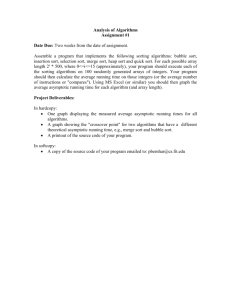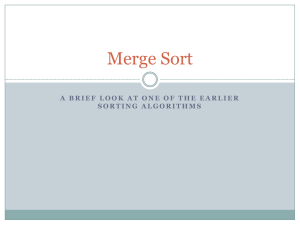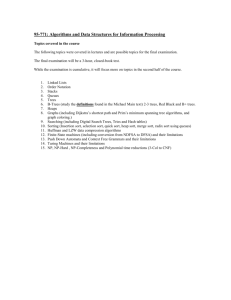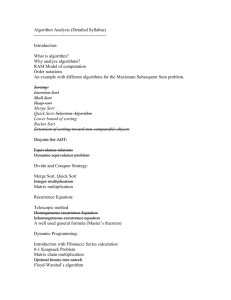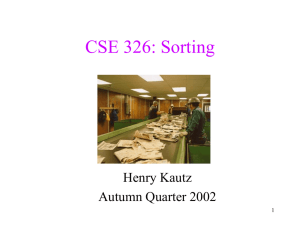MergeSortActivity
advertisement
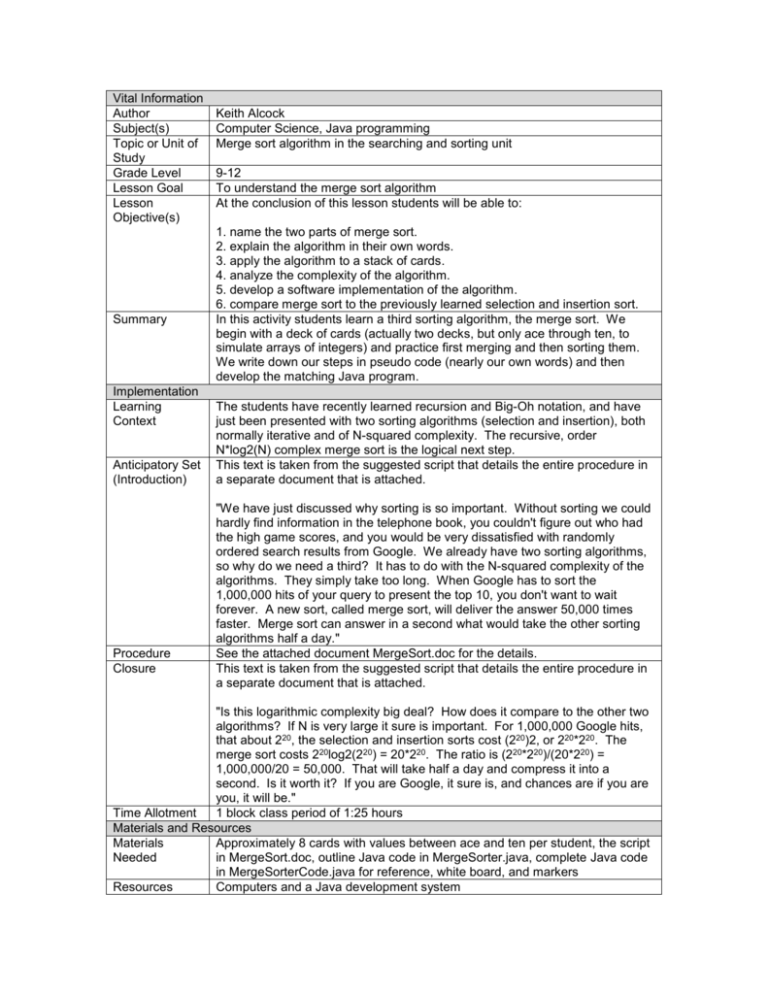
Vital Information Author Subject(s) Topic or Unit of Study Grade Level Lesson Goal Lesson Objective(s) Summary Implementation Learning Context Anticipatory Set (Introduction) Procedure Closure Keith Alcock Computer Science, Java programming Merge sort algorithm in the searching and sorting unit 9-12 To understand the merge sort algorithm At the conclusion of this lesson students will be able to: 1. name the two parts of merge sort. 2. explain the algorithm in their own words. 3. apply the algorithm to a stack of cards. 4. analyze the complexity of the algorithm. 5. develop a software implementation of the algorithm. 6. compare merge sort to the previously learned selection and insertion sort. In this activity students learn a third sorting algorithm, the merge sort. We begin with a deck of cards (actually two decks, but only ace through ten, to simulate arrays of integers) and practice first merging and then sorting them. We write down our steps in pseudo code (nearly our own words) and then develop the matching Java program. The students have recently learned recursion and Big-Oh notation, and have just been presented with two sorting algorithms (selection and insertion), both normally iterative and of N-squared complexity. The recursive, order N*log2(N) complex merge sort is the logical next step. This text is taken from the suggested script that details the entire procedure in a separate document that is attached. "We have just discussed why sorting is so important. Without sorting we could hardly find information in the telephone book, you couldn't figure out who had the high game scores, and you would be very dissatisfied with randomly ordered search results from Google. We already have two sorting algorithms, so why do we need a third? It has to do with the N-squared complexity of the algorithms. They simply take too long. When Google has to sort the 1,000,000 hits of your query to present the top 10, you don't want to wait forever. A new sort, called merge sort, will deliver the answer 50,000 times faster. Merge sort can answer in a second what would take the other sorting algorithms half a day." See the attached document MergeSort.doc for the details. This text is taken from the suggested script that details the entire procedure in a separate document that is attached. "Is this logarithmic complexity big deal? How does it compare to the other two algorithms? If N is very large it sure is important. For 1,000,000 Google hits, that about 220, the selection and insertion sorts cost (220)2, or 220*220. The merge sort costs 220log2(220) = 20*220. The ratio is (220*220)/(20*220) = 1,000,000/20 = 50,000. That will take half a day and compress it into a second. Is it worth it? If you are Google, it sure is, and chances are if you are you, it will be." Time Allotment 1 block class period of 1:25 hours Materials and Resources Materials Approximately 8 cards with values between ace and ten per student, the script Needed in MergeSort.doc, outline Java code in MergeSorter.java, complete Java code in MergeSorterCode.java for reference, white board, and markers Resources Computers and a Java development system Standards & Assessment Standards This subject area is not standardized. Evaluation Understanding is checked throughout the presentation, but the real test is whether or not students understand the algorithm well enough to implement it themselves. Students complete the outline Java code in MergeSorter.java and run it on the included test cases until the code passes. Associated text from the procedure section is as follows: "Let's check our list again. What are the two parts? Do we have an explanation? If I give you a pile of cards, can you sort them this way? What is the complexity? How does it compare with the other algorithms? Now the tough question: Can you write a program that implements this algorithm? Let's see. Find the file MergeSorter.java in Mr. Hopley's directory and give it a try. Several test cases are included for your convenience. The program is about 25 lines of code, but they can be tricky. If you can write them in less than half a day, you'll still come out ahead."
